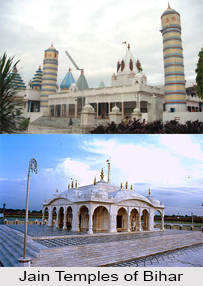 Jainism in Bihar was quite prevalent in the modern world religion. Lord Mahavira, the patron of Jainism, visited the most important cities of Bihar during his wanderings. And he was welcomed everywhere with warmth. King Bimbisara (Jainas called him by the name Srenika) of Magadha, also patronized Buddha. Buddhism and Jainism both are equivalent in Bihar.
Jainism in Bihar was quite prevalent in the modern world religion. Lord Mahavira, the patron of Jainism, visited the most important cities of Bihar during his wanderings. And he was welcomed everywhere with warmth. King Bimbisara (Jainas called him by the name Srenika) of Magadha, also patronized Buddha. Buddhism and Jainism both are equivalent in Bihar.
Inception of Jainism
Bimbisara was considered by the Jainas as a special admirer of their master. They, therefore, presumed that he would be born as a Tirthankara in his later existence. Even Ajatashatru (Kunika), Bimbisara`s cruel son, who caused his father`s death by starvation, was well-disposed towards Jainas. His successor Udayi was in fact a patron of their doctrine. The religion flourished even under the dynasty of the "N andas" who had (at the time when Alexander the great marched into India) usurped the throne of the Sishunaga-kings, and there was no change in the situation even when the last unpopular Nanda-king was relieved of his throne by the great Maurya King Chandragupta Maurya.
Jainism in Maurya Empire
Jainas reckon this first historical emperor of India and also his great chancellor Chanakya among Jains. Chanakya is said to have been a son of a Jaina-layman Chani. Historical records say that Chanakya had influenced Chandragupta towards the Jaina religion. It is said that Chandragupta was influenced to such an extent that he himself became a diligent Jaina that he renounced finally his throne in accordance with the Digambara tradition, became an ascetic and went to Mysore along with Saint Bhadrabahu and he is said to have lived and died there in Sravana Belgola in a cave.
Jainism under Ashoka
With regard to the relationship of Jainism with Bihar it can be said that Ashoka was a great and a far-sighted ruler who particularly made it a point to promote the religious and moral life in his great empire. He, therefore, supported the religious brotherhoods of his land in a liberal manner. Personally, he embraced Buddhism in his later years, and he is considered to be its "Constantine"; Jainas, however, opined that he belonged earlier to their religion.
Jainism after Maurya Empire
According to the early Indian history, Ashoka`s successors on the throne of Magadha were his grandsons Dasaratha and Samprati since his son Kunala was blind. The Jaina-tradition mentions only Samprati who is said to have resided in Ujjain, and describes him as a patron of their faith. He is said to have been converted by the famous monk Suhasti and erected numerous temples. The later period considered him to be a founder of temples to such an extent that many buildings whose origin was forgotten, were ascribed to him. It is even said that Samprati developed a lively missionary activity and even erected Jaina-monasteries in non-Aryan regions.




















